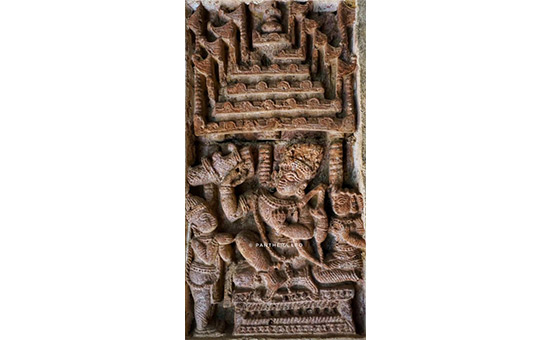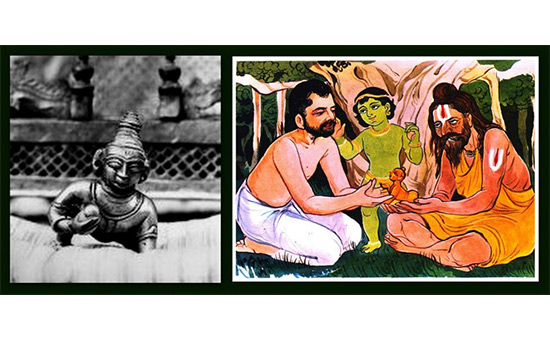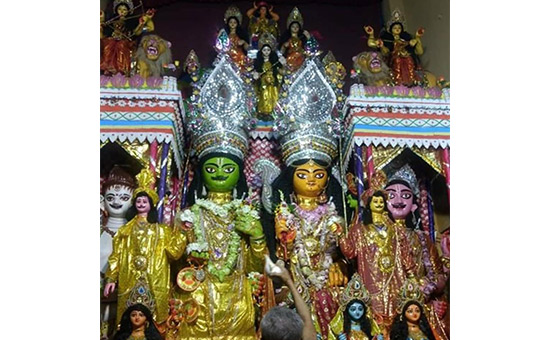- Article
provides cultural and historical evidence to show that Sri Ram was widely
worshipped in West Bengal.
Mahakavi Krritibas Ojha (1381–1461), a well-known poet from Bengal, was the author of “Sri Rampanchali,” the Bengali version of the Sanskrit Ramayan. While he had largely changed the narrative of Valmiki’s Ramayan and made many additions of his own (making Ram quite different from the original one), nevertheless the book became the lifeline of all Ramayat Vaishnavites (pre Chaityna era) in Bengal.
This
love for Ram is so evident in innumerable Temple terracotta plaques, personal
names, place names, daily idioms, Ram naam jap to dispel fear by children to
adults, folk theatres/dances and folk songs, puppet shows, and even politics,
where Raghupati keeps appearing frequently. 100 years back Sir Ashutosh
Mukherjee started celebrating the birth anniversary of this Ramayan Mahakavi,
yet now we see that both Krritibas and his Ram have been almost exiled from
West Bengal.
The newest version doing the gossip rounds is that Ram is an outsider and doesn’t belong to WB.
Well, nothing can be more farther than the truth. Prior to Gaurio Vaishnavism of Sri Chaityna (1486–1533) it was the Ramayat form of Vaishnavism that prevailed in Bengal. In fact the biographer of Sri Chaityna, Jayanand’s family worshipped Ram as their kul devta. The gossip that Ram is an outsider and was never worshipped in Bengal is calculative in its spread, & the historical fact that has been used to do it was that in 1112 CE Shovanath Chandra in Sribati established a Raghunath Jeur temple (they built three terracotta temples). This is a family of Gujarati traders, and their puja still continues.
Two more names crop up from western India (Ramanand Tewari and a certain Madhav Rao) who settled in Bengal and also started the puja of Ramchandra. However, beyond these names innumerable Bengali names crop up too, who were also so to say “Ram bhakts”, including the families of Sri Ramakrishnadev, Mahakavi Chandidas, etc. So terming Ram as an outsider in WB is not only a gross historical distortion, it’s a blatant lie with distinct political motives (we all know who came to power in WB and ruled for 3 decades, destroying the state completely, and sadly the trend continues).
 Depiction of Rama on a Bengal temple terracotta plaque. Photo by Samata.
Depiction of Rama on a Bengal temple terracotta plaque. Photo by Samata.
What actually happened in Bengal was that Ramayat Vaishnavism
got mixed with Gaurio Vaishnavism, and the latter took control. In simple
words, Krishna took precedence over Rama, because of the immense popularity of
Sri Chaityna and Gopal was preferred over Sitanath, but the latter never
entirely disappeared in that sense.
Visit the village of Gohogram in east Bardhaman, to understand how Ram
is still a living tradition in WB (beyond the only too vocal yet empty-headed
urban leftists and their thug allies), where on Ramnavami the entire village
lights up with the colours of abir (gulal). This village has the Bhattacharya
family that are Rama-sevayats, and they have a beautiful black stone carved
murti of Rama with a murti of Sita in astadhatu. Still today Ram and Sita are
worshiped thrice in a day, and during Ram Navami a large festival takes place
where Ram and Sita after being bathed with 108 pots of water are worshipped. In
the evening the Dolyatra takes place where the entire village plays with abir
or gulal.

THAKUR & RAM-LALA
Thakur
Ramakrishna Paramahamsa had deep bonds of love with the little deity of child
Rama or Ram Lalla. Ram lalla was the ishta devata of a ramaait sadhu named
Jatadhaari from north India who had visited Dakshineshwar and stayed for some
time on the banks of Ganga. During his stay Thakur was in a mood of Ram sadhana.
He began to see Ram lalla as a living entity. Ram lalla used to go to take
baths in Ganga with Thakur but used to splash water and make a mess and refuse
to leave water even when time was over. Ramakrishna had to admonish him
repeatedly to get him out of water.
Once when Ram lalla was hungry, Thakur gave him some flattened rice which he had at his disposa. The rice contained a few husks and Ram Lalla cut his mouth. Seeing this Thakur began to cry saying–“Maa Kaushalya had fed you with the best butter and kheer, and I gave you this crude rice to eat. How wretched am I! “When the day arrived for Jatadhaari to leave, Ram lalla appeared to him in a dream and asked him to give himself to Thakur. Jatadhaari left Ram lalla in the loving care of Ramakrishna. He remained in the garbhagriha of Dakshineshwar until he was stolen along with other valuables during a theft in the temple. Perhaps, in the absence of the deep love that Thakur showered on him , Ram lalla chose to un-manifest himself forever.
JAI RAM. JAI RAGHUNATH JAI RAM
Ever since the Ram Janmabhoomi movement gained momentum in the late 1980s, historians, politicians and others belonging to the Left and ‘pseudo-liberal’ cabal in Bengal have been propagating a myth: that Bhagwan Ram is alien to Bengal and that Bengalis never worshipped that deity.
The
false narrative spun and circulated by them was that
Bengalis always belonged to the Shakti cult and were
worshippers of the Mother Goddess. Bhagwan Ram, they thus concluded, had no
place in the Hindu pantheon of deities revered and worshipped in Bengal.
The
gathering strength of the BJP, which is closely associated with the Ram
Janmabhoomi movement, in Bengal, and the enthusiastic celebration of Ram Navami
all over the state in recent years led to the proponents of this false
narrative pushing it very aggressively. The Trinamool and its supporters in
academia also pushed this narrative in a futile bid to wean away the masses
from the BJP.
Full-throated Jai
Shree Ram slogans that reverberated across the State heralded the handsome
gains made by the saffron party in the Lok Sabha elections last year.
 Worshipping Ram and Sita in Ramrajatola in Howrah, WB.
Worshipping Ram and Sita in Ramrajatola in Howrah, WB.
An angry Mamata Banerjee ordered police to take action against those raising that slogan. She even termed the religious slogan an abuse. Many ‘intellectuals’ like Amartya Sen endorsedcthe fake narrative about Bhagwan Ram being alien to Bengal.
However,
Hindu scholars, historians and others have effectively debunked this narrative.
They have proved that Bhagwan Ram has been worshipped by Bengalis down the
ages. And that Bengali Hindus have always been an integral part of the Sanatan
parivar.
Delhi
University history professor Saradindu Mukherjee, who was part of a group of
eight eminent historians and archaeologists who collected and collated evidence
of the existence of a Ram Mandir at Ram Janmabhoomi, has been a prominent voice
in Bengal to unmask the fake narrative.
Speaking
to Swarajya, Mukherjee said there are innumerable accounts in ancient and medieval Bengal of Bhagwan Ram being worshipped. “The Krittibas Ramayan written by the 15th century Bengali poet Krittibas Ojha is the best example of Ramayan’s intricate link with Bengal. Krittibas wrote the Ramayan about 200 years before Tulsidas,” said Mukherjee.
Many
litterateurs of ancient, medieval and modern Bengal have also written about and
celebrated Bhagwan Ram, said Mukherjee. During British rule, Meghnad
Badh (the slaying of Ravan’s son Meghnad) by Michael
Madhusudan Dutta was considered to be one of the greatest
literary works of Bengal.
“Nobel laureate Rabindranath Thakur, Bankim Chandra Chattopadhyay, late 19th century historian and ICS officer Ramesh Chandra Dutta and many others wrote poems and prose eulogising Shree Ram and about the Ramayan. Michael Madhusudan Dutta had said that studying the Ramayan is essential for anyone trying to understand Bharatvarsh,” said Mukherjee.
Both Bankim Chandra Chattopadhyay and Rabindranath Thakur, he added, had said that Ramayan is not a myth but a great epic that documents real-life incidents in ancient India. “There are many popular proverbs and dictums around Bhagwan Ram and the Ramayan. All these prove that Bengali Hindus revered and worshipped Shree Ram just like Hindus in other parts of the country,” Mukherjee added.
Veteran journalist and BJP leader Rantidev Sengupta said that there are 25 ancient Ram Mandirs all over Bengal. “Rabindranath Thakur had said that Ramayan is not just an epic but a national treasure and an essential part of India’s civilisational history,” he added.
Hindu Samhati president and scholar Debtanu Bhattacharya points to the ‘Gouriya Ramayan’, or the Ramayan that existed during the ancient Gour era (of Bengal) that finds mention in Chanakya’s Arthashastra. “The patal khanda of Padma Puran that deals with Ramayan was very popular and frequently recited in Bengal. Apart from Krittibas Ojha, there were 51 scholars and poets who wrote the Ramayan in ancient and medieval Bengal,” he said.
“In the ‘rarh’ region of Bengal (sandwiched between the Chotanagpur plateau and the Gangetic delta), the ‘Bishnupuri Ramayan’ written by Sankar Kobichandro was very popular. There are many books and scriptures of ancient and medieval Bengal about Ramayan and Bhagwan Ram,” he said.
Bhattacharya, Sengupta and Mukherjee point out that the best body of evidence that Bhagwan Ram has always been part of Bengal lies in the many names of people and places containing ‘Ram’. One of Bengal’s greatest saints, Ramakrishna Paramahans, belonged to a family of devout Ram bhakts.
“Ramarkishna’s grandfather’s name was Manikram Chattopadhyay, his father’s name was Khudiram and his brothers were Rameshwar and Ramkumar. From the ancient times, Berngalis would name their children after Shree Ram, and thus we have names like Rammohan, Ramprasad, Ramkinkar, Ramesh and many more. Places like Rampurhat and Ramchandrapur have ‘Ram’ in the names”, they said.
Poet and writer Binayak Bandopadhyay said that it is totally inconceivable that Ramayan spread to Southeast Asia bypassing Bengal. “Shree Ram and Ramayan were worshipped in Myanmar, Malaysia, Indonesia, Singapore, Laos, Cambodia and Vietnam. Ramayan still finds primacy in the culture of those countries. It just cannot be that the Ramayan went to those countries from India bypassing Bengal,” he said.
Bandopadhyay points out that the great 19th century saint Bamacharan Chattopadhyay, better known as Bama khepa (khepa means mad in Bangla) was an ardent devotee of Ma Tara (Goddess Kali). “But he used to worship Shree Ram also and used to participate very enthusiastically in Ram Navami celebrations,” he said.
Eminent musician and Hindu scholar Somjit Dasgupta points out that worship of Shree Ram, Devi, and Vishnu continued syncretically and harmoniously in ancient, medieval and modern Bengal. “Buddhist caves in Bengal had carvings showing Shree Ram and ancient Vishnu temples in Bengal showed Ram and Buddha as the avatars of Vishnu,” he said.
“How does one explain the Ayodhya Pahar (Ajodhya Hills) of Purulia if Ram is alien to Bengal? How do we have a Sita kund in Chattogram (present-day Bangladesh) that Swami Vivekananda visited? The famous terracotta mandirs of Bishnupur, including the 108 Shiv mandirs, depict the ten avatars of Vishnu, including Shree Ram,” he pointed out.
“The ancient and famous patachitra (scroll paintings) of Bengal depict scenes from the Ramayan. Ram is revered by the adivasis in Bengal’s Jangalmahal and their famous Chhau Dance enact
scenes from the Ramayan. The jatras (folk theatre) of Bengal were centered around Ramayan and Mahabharat,” he said.
Ramakrishna Paramahans, said Dasgupta, was an ardent devotee of Goddess Kali, but had famously said: “Je Ram, shei Krishna” (Ram and Krishna are one).
Chaitanya Mahaprabhu,
the late 15th century Vaishnavite saint of Bengal, used to preach the Ramayan
as well and extol the virtues of Shree Ram as Maryada Purushottam in
his discourses.
Both
Binayak Bandopadhyay and Debtanu Bhattacharya say that the propagation of the
narrative by Leftists and pseudo-liberals that Bengali Hindus worship Shakti (or Devi)
exclusively is a sinister attempt to make Bengali Hindus rootless.
“This (creation of the fake narrative) is an elaborate plot to divorce Bengali Hindus from the greater Hindu samaj and the Sanatan Dharm and take Bengali Hindus away from mainstream Hindu society. The objective is to create a society of deracinated Hindus who will not oppose an eventual integration of Bengal in Islamic Bangladesh or a takeover of Bengal by Islamists,” said Bhattacharya.
Endorsing this, Bandopadhyay said that this fake narrative is meant to distance Bengali Hindus from their religious, cultural and civilisational roots and heritage. “Just as the worship of Devi was not exclusive to Bengal, the worship of Shree Ram was not exclusive to North India as Left academics would like us to believe,” he
said.
“We recite the Devi Kavacham stotram in praise of the Nava Durga (nine different forms of Goddess Parvati) before Chandi paath. Are all the Nava Durga mandirs located in Bengal? Aren’t they spread all over India? Aren’t Kamakhya, Meenakshi, Kalka, Vishalakshmi, Parvati, Uma and Sati all manifestations of Adi Shakti Mahamaya?
“There are lots of Durga Mandirs in Kashi (Varanasi). At the beginning of all Hindu religious and social occasions, the mantra that is recited (Gangei cha Yamunei chaiva…) takes the names of Ganga, Yamuna, Godavari, Saraswati, Narmada, Sindhu and Kaveri. This mantra binds Bharatvarsha into one. So who are Leftists to divide us? Their evil designs will never succeed,” said Bandopadhyay.
Eminent scholar Anirban Ganguly
, who is also the director of Dr Syama Prasad Mookerjee Research Foundation, said there is a mountain of empirical evidence to prove Bhagwan Ram’s inalienable link with Bengali culture, tradition, religious practices and consciousness.
“Shree Ram enjoys an inviolable and sacrosanct place in the heart and mind of every Bengali Hindu who is conscious of his history and heritage. Those who try to say otherwise are charlatans,” he said.
To read all
articles by author
Author studies life
sciences, geography, art and international relationships. She loves exploring
and documenting Indic Heritage. Being a student of history she likes to study
the iconography behind various temple sculptures. She is a well-known columnist
- history and travel writer. Or read here
Article was first published on author’s blog and here Article and pictures are
courtesy and copyright author.